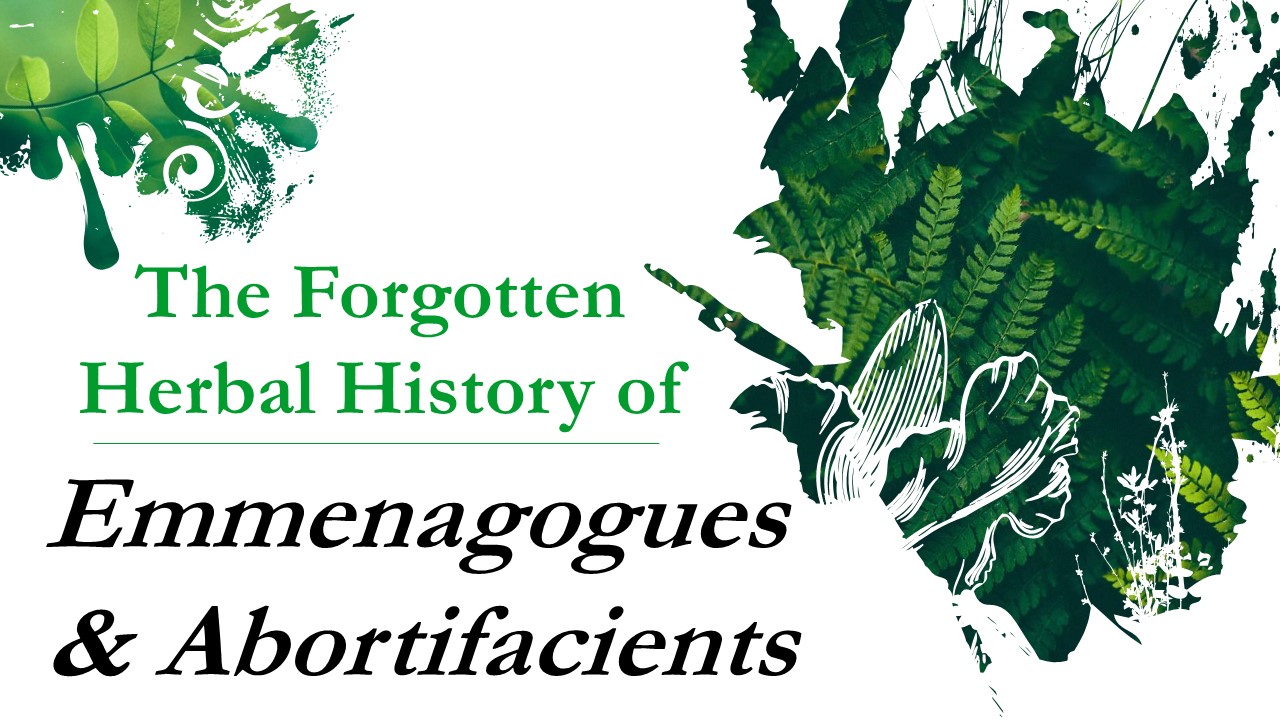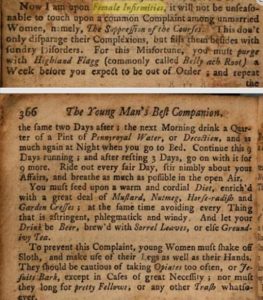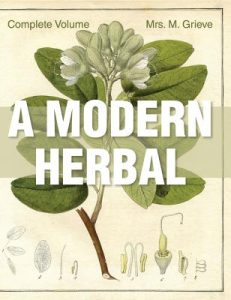We all joke about the dubious search histories of authors. A mystery writer might search “best ways to hide a body.” Crime and thriller writers might search “how to hide drugs in your car.” So, what’s in my search history? Abortifacients and emmenagogues.

My trilogy, The Kenetlon Sagas, is set in the Iron Age, so women’s health was reliant on herbs—lots of them.
Emmenagogue. A herb which stimulates blood flow in the pelvic and uterine regions in order to induce menses. The word is derived from ancient Greek: emmen (monthly/moon) + agogos (evoking.)
Reasons women use emmenagogues vary widely, but the most common is to treat delayed menstruation. Menses can be absent or delayed for many reasons: hormonal changes, disorders like oligomenorrhea, and even stress. Women who wanted to change their menstrual cycle so it wouldn’t coincide with an important event (like her wedding) or to simply to bring regularity to otherwise irregular cycles also took emmenagogues.
The most sought-after herbal emmenagogue in antiquity was Silphium. It was used widely across the Mediterranean region and was so valuable to the City of Cyrene that its image adorned their coins. Roman poetry declares the herb was worth its weight in gold. Ancient Egyptians had hieroglyphs depicting the plant. In addition, silphium even makes an appearance in the Bible. Not only was abortion permissible in biblical times, but women could be forced to endure abortions against their will. In such cases, priests actually oversaw the abortions (Numbers 5:11-31) at the behest of the woman’s husband or parents.
Silphium is presumed to be extinct now. The last known stock was harvested and shipped to the Emperor Nero as a gift prior to his death in 68 AD. However, in 2021 researchers in Turkey believe they may have located a surviving patch of Silphium. Should the discovery prove true, it could be a boon for women the world over who wish to add it to their gardens.
As exciting as Silphium is, its native habitat was too far south for my story and though it was a popular trade good at the time, my character was unlikely to be able to afford it in the quantities needed. That left me questing for other herbs and I eventually settled on pennyroyal.
Pennyroyal is in the mint family and produces delicate purple blossoms. The crushed leaves smell strongly of spearmint. It’s a traditional folk remedy as an emmenagogue, abortifacient, and culinary herb. In large doses, it’s toxic to the liver and can caused death.
Queen Anne’s Lace is also reputed to be an emmenagogue. Queen Anne II was born in 1665 and is recorded as having 18 pregnancies before her death in 1741. Only 5 of those pregnancies were carried to term. The plant bears Queen Anne’s name because her “miscarriages” were rumored to be the result of ingesting the herb. That makes Queen Anne’s Lace an abortifacient as well as an emmenagogue.
Abortifacient. Any substance that induces miscarriages or abortions. The word derives from Latin: abortus (miscarriage) + faciens (making.)
Ancient medical texts are filled with pharmacological references to abortion inducing herbs. Pennyroyal and silphium were by no means the only plants with these qualities–dozens of herbs have been catalogued and their effectiveness recorded by early scholars and physicians. Detailed accounts of the use of abortifacients appear in works by Aristotle, Hippocrates, Pliny, and many others.
The use of emmenagogues and abortifacients was legal throughout Europe and the Americas for much of recorded history. Eager scholars can glean mountains of information on the topic from any number of historical texts.
In his 1749 edition of Materia Medica, Carl Linnaeus, “the father of botany” listed 5 abortifacients. In Plants and Empire: Colonial Bioprospecting in the Atlantic, science historian Londa Schiebinger writes, “many sources taken together – herbals, midwifery manuals, trial records, Pharmacopoeia, and Materia Medica – reveal that physicians, midwives, and women themselves had an extensive knowledge of herbs that could induce abortion.”
In Birth Control and Abortion in Canada, 1870-1920, historian Angus McLaren, states, “A woman would first seek to ‘put herself right’ by drinking an infusion of one of the traditional abortifacients, such as tansy, quinine, pennyroyal, rue, black hellebore, ergot of rye, sabin, or cotton root.” In America, mail order abortifacients were available well into the 19th century.
Abortion was so common and widely accepted in the United States that an estimated 20% to 25% of all pregnancies ended in abortion during the 18th and 19th centuries. It is not surprising then, that one of America’s founding fathers, Benjamin Franklin, published a recipe for an abortifacient in the 1748 edition of The American Instructor and warns readers to be very careful when measuring ingredients. The recipe first appeared in John Tennent’s The Poor Planter’s Physician in 1734 and was appended to Franklin’s book with permission of the author.
Benjamin Franklin & John Tennent’s Recipe:
For this Misfortune, you must purge with Highland Flagg, (commonly called Bellyach Root) a Week before you expect to be out of Order; and repeat the same two Days after; the next Morning drink a Quarter of Pint of Pennyroyal Water, or Decoction, with 12 Drops of Spirits of Harts-horn, and as much again at Night, when you go to Bed. Continue this 9 Days running; and after resting 3 Days, go on with it for 9 more.
 Highland Flagg/Bellyache Root is commonly known as angelica. Harts-horn is a common name for the American pasqueflower. Herbalist Gregory L. Tilford documented its use as an abortifacient used by Native Americans in “Edible and Medicinal Plants of the West.”
Highland Flagg/Bellyache Root is commonly known as angelica. Harts-horn is a common name for the American pasqueflower. Herbalist Gregory L. Tilford documented its use as an abortifacient used by Native Americans in “Edible and Medicinal Plants of the West.”
Benjamin Franklin’s publication of the abortion recipe was not a singular event, either. It continued to be included through at least the 10th edition of The American Instructor, published by Franklin and Hall in 1758. Though, the 10th edition does add, “To avoid this complaint, young women must … be cautious about taking opiates too often, … nor must they long for pretty fellows or other trash whatsoever.” So, it seems that drugs and womanizers were just as prevalent in the 1700s as they are today.
It wasn’t until 1869 that Pope Pius IX instated a ban on abortions after quickening. (Quickening occurs around 20 weeks of pregnancy.) The ban was only applicable to practicing Catholics. Abortions remained legal under secular governments. But, owing to the continual prodding of the Catholic Church, governments slowly began changing course on abortion.
The 1873 Comstock Law outlawed the publication of information pertaining to the procurement of abortion. The law further prohibited medical students from learning about contraception and the prevention of venereal disease. By 1910 nearly every state had outlawed abortion.
Anti-abortions laws remained in-place in the United States from 1910 until 1973, when the Supreme Court ruled that forbidding abortion was illegal in Roe vs. Wade. The ruling reaffirmed American women’s reproductive rights and returned the nation to the status-quo enjoyed by the Founding Fathers, Benjamin Franklin included.
The 2022 case, Dobbs v. Jackson Women’s Health Organization, overturned the Supreme Court’s previous ruling. In a post-Dobbs world, women are likely to seek herbal remedies once again. The good news is, there are a plethora of emmenagogues and abortifacients available—some may already be growing in your gardens or sprouting along roadsides in front of your house. However, these herbs should be used with caution. Many abortifacients and emmenagogues are toxic when taken in large doses. Worse, several have poisonous look-a-likes. A prime example is Queen Anne’s Lace, which looks strikingly similar to deadly water hemlock.
 Herbal Reference Book
Herbal Reference Book
I strongly recommend that anyone interested in the medicinal uses of plants acquire a copy of the following book:
Grieve, Margaret. “A Modern Herbal: The Medicinal, Culinary, Cosmetic and Economic Properties, Cultivation and Folklore of Herbs, Grasses, Fungi, Shrubs & Trees with their Modern Scientific Uses.” Complete Volume. Stone Basin Books. 1931.
The book is presently available to order from BookPeople of Moscow. Expected delivery time is 2 to 10 days depending on which warehouse it will be shipped from.
Mrs. Grieve’s extensive herbal lists plant descriptions, natural habitats, and tips for cultivation. For reference, both the Latin and common names are listed, or as is often the case, a string of common names. The book also includes information regarding which parts of the plants are used (berries, leaves, roots, bark, etc.) as well as providing information on preparation and dosages. Poisonous plants are notated.
In addition, there are a number of extensive online resources available:
- Emmenagogue | Encyclopedia of Herbology (shirleytwofeathers.com)
- Herbs With Emmenagogue Properties — Mercurial Consciousness
- Emmenagogue | The Naturopathic Herbalist
- Medicinal plants to stimulate menstruation – Botanical online (botanical-online.com)
- Botanical Medicine for Women’s Health | ScienceDirect
- ·The Emmenagogues – East West School of Planetary Herbology (planetherbs.com)
**The information presented in this blog post is for education only and is not intended as medical advice. If you have health concerns, you should always check with your health care provider before self-administering herbs.**

This time I will make more of an effort to proof read my comment…You really do your homework for your writing, its pretty impressive. I find it interesting that a plant can become “extinct” and I wonder if it was due to over harvesting or if it was due to political/religious zealousness. Either way I’m now curious about the plant and in this case curiosity may or may not kill some cats.
“Jitterbug Perfume” mentions penny royal as a form of birth control but I had also heard that penny royal will scramble your brain, you also mentioned ergot which is where the term “the devil is in the rye” comes from. I have heard that ergot will cause necrosis of the extremities, as well as hallucinations, while I like hallucinogens as much as the next Guy, the fingers and toes falling off is a little off putting. If I wanted that I would do more winter camping. Still it makes me wonder how much of the “dangers” are true and how much of those “dangers” are manufactured by “The Man”
A sure fire means of identifying water hemlock, other than feeding some to the neighbor kid, is that water hemlock is smooth it has no little hairs on it, Queen Annes Lace is hairy and when in bloom it will have one little red or purple flower in the middle of its all white umbral style flowers. Its like mushroom identification, once you see it you know it.
All of this is to say as we humans march forward with all of our pharmaceutical advances we have allowed too much knowledge to die on the vine, our baked in fear of witchcraft has robbed us of safer more practical means of healthcare. I imagine we will add “A Modern Herbal” to our library of practical knowledge.
Thanks for making us think.
Greetings Runner Bean–
Deadly Hemlock also has purple spots/splotches on the stems. It grows all over this region, especially in ditches. I saw a post last week of a little girl in Moscow with a horrendous rash from trying to pick hemlock flowers–it stings worse than nettles!
The warnings regarding herbal abortion remedies should be heeded. A lot of the plants are toxic in large quantiles. I have a botanist friend, formerly of Palouse (Steve Gill), and I run all my herbal ideas by him first–just to make sure I don’t accidently kill someone.
I like how you said “accidently” kill someone.
I apologize for “Man Splainin'” hemlock. You are right, Purple splotches as well as streaks are a good marker, I feel like QAL can have purple in the stems and foliage as well, my go to has always been to look for fuzz or hair. We have both here at the farm, I think my Grand Dad must have planted the QAL, maybe. The hemlock is up by a neighboring property, that is a subtle way of saying it is coming from the neighbors. My goal is to keep it out of the pasture, if anything is going to kill the sheep it should be the freezer. Animals must be smart enough to know its poisonous, I keep hoping to see dead deer, did I say that out loud? Sometimes animals will die from eating yews, which strikes me as odd because I think its an Idaho native.
Nettles are awesome, delicious right? We went out of our way to plant some. I guess some people will pay extra for the sting. Hah